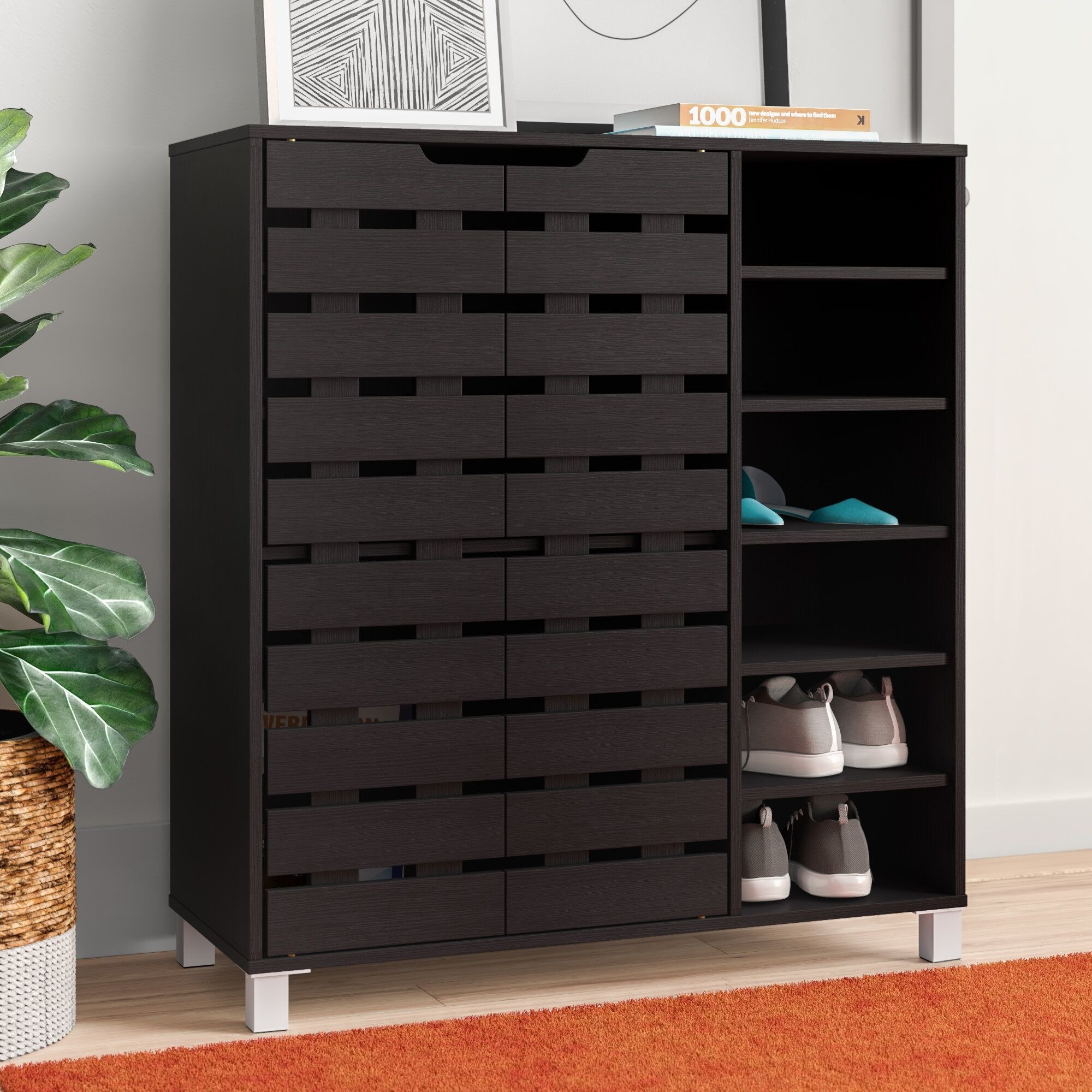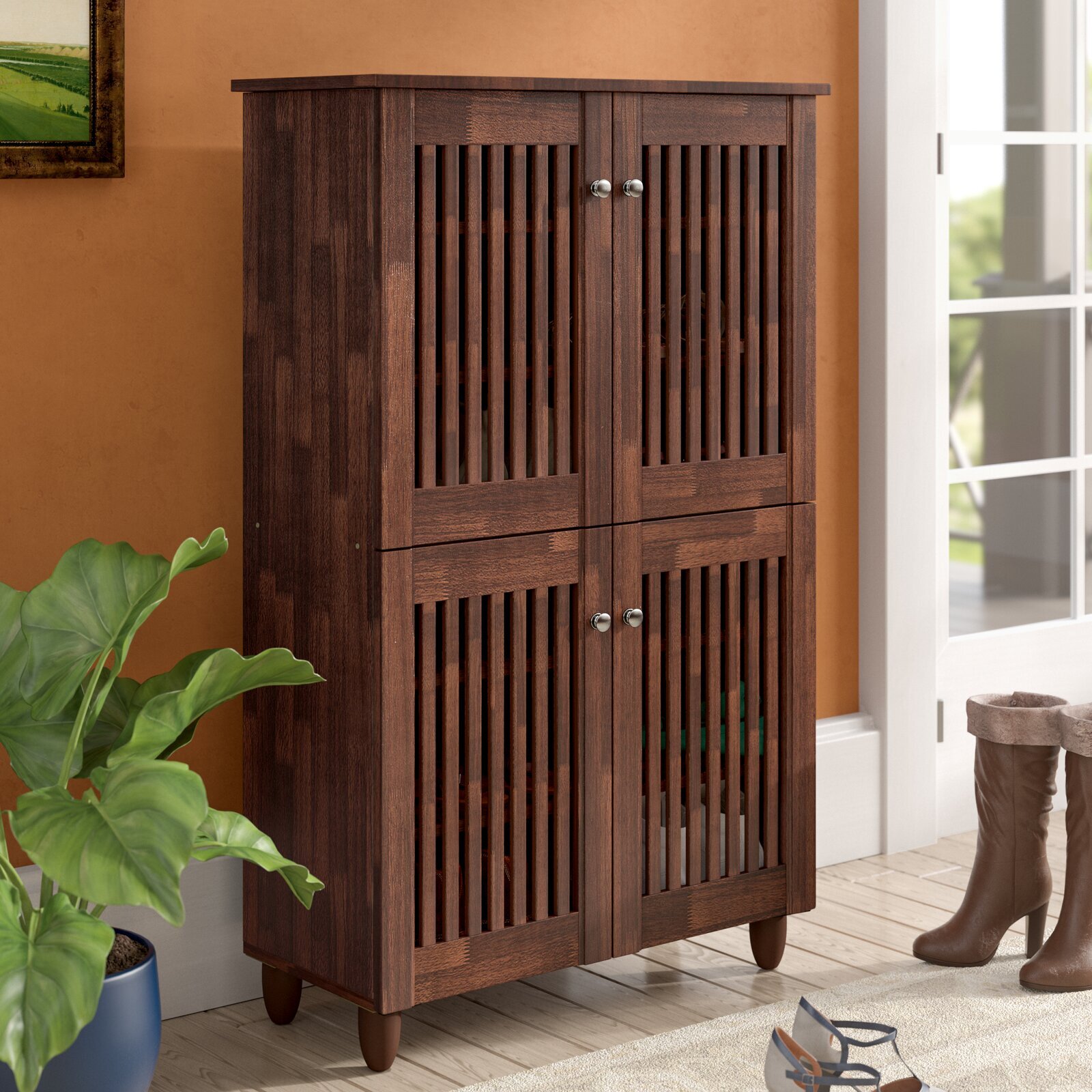Design & Dimensions of Narrow Shoe Cabinets with Doors

Narrow shoe cabinets are a practical solution for maximizing space in hallways, entryways, or even bedrooms. Their slender profile allows them to fit into tight spaces, while doors keep shoes neatly hidden and dust-free. This section details three distinct narrow shoe cabinet designs, exploring their dimensions, material choices, and construction.
Three Narrow Shoe Cabinet Designs, Narrow shoe cabinet with doors
We’ll Artikel three models, each with varying dimensions and material suggestions to suit different needs and aesthetics. These are just examples; adjustments can be made to accommodate specific space constraints and personal preferences.
Narrow shoe cabinet with doors – Model A: The Slimline
This model prioritizes maximizing storage in the smallest footprint. It’s ideal for narrow hallways or small entryways.
- Height: 120cm
- Width: 30cm
- Depth: 20cm
- Material: MDF (Medium-Density Fiberboard) with a white laminate finish for easy cleaning and a modern look. Simple metal hinges and a small, discreet handle.
Model B: The Mid-Sized
This offers a balance between storage capacity and space efficiency. It’s suitable for a range of locations.
- Height: 150cm
- Width: 40cm
- Depth: 25cm
- Material: Solid pine wood stained a dark walnut for a classic and warm aesthetic. High-quality wooden hinges and a stylish knob handle.
Model C: The Tallboy
This design prioritizes storage capacity over minimal footprint. It’s perfect for larger entryways or areas where vertical space isn’t a constraint.
- Height: 180cm
- Width: 45cm
- Depth: 30cm
- Material: Plywood with a natural veneer finish for a sustainable and visually appealing option. Strong, durable hinges and simple, flush-mounted handles.
Storage Capacity Comparison
The storage capacity will vary depending on shoe size and style. This table provides an estimated capacity, assuming a mix of women’s and men’s shoes.
| Model | Height (cm) | Depth (cm) | Approximate Capacity (Pairs of Shoes) |
|---|---|---|---|
| Slimline (A) | 120 | 20 | 10-12 |
| Mid-Sized (B) | 150 | 25 | 18-22 |
| Tallboy (C) | 180 | 30 | 25-30 |
Construction Process: Model A (Slimline)
This Artikels the steps for building the Slimline model. Appropriate safety precautions should be taken at all times when using power tools.
Step 1: Cutting the MDF
Using accurate measurements, cut the MDF sheets to the dimensions specified for the sides, top, bottom, shelves, and back panel. A table saw or circular saw is recommended for clean cuts.
Step 2: Assembling the Carcass
Apply wood glue and screws to join the sides, top, bottom, and back panel. Clamps will ensure a tight and even join while the glue dries. Ensure the cabinet is square and true using a square and level.
Step 3: Installing Shelves
Position and secure the shelves using shelf supports or brackets. Ensure shelves are level and evenly spaced.
Step 4: Attaching Doors and Hardware
Attach the doors using hinges, ensuring they are aligned correctly and open and close smoothly. Install the handles.
Step 5: Finishing
Apply a final coat of laminate to seal the edges and enhance the appearance. This also adds to the durability of the cabinet.
Necessary Tools: Table saw or circular saw, drill, screwdriver, clamps, measuring tape, level, square, wood glue, screws, hinges, handles, sandpaper, laminate.
Styles and Features of Narrow Shoe Cabinets with Doors: Narrow Shoe Cabinet With Doors

Choosing the right narrow shoe cabinet involves considering not just its dimensions but also its style and features. The style should complement your existing décor, while the features should enhance both functionality and convenience. Let’s explore some popular styles and essential features to consider.
Narrow Shoe Cabinet Styles
Different styles offer diverse aesthetic appeals and suit various interior design schemes. Here are five examples:
- Modern Minimalist: Characterized by clean lines, simple shapes, and a neutral color palette (often white, black, or light gray). Minimalist cabinets typically feature sleek handles or handleless designs and often incorporate materials like high-gloss lacquer or matte-finish wood. The overall effect is one of understated elegance and spaciousness, perfect for contemporary homes.
- Rustic: Rustic styles embrace natural materials and a more aged, worn look. Expect to see visible wood grain, possibly distressed finishes, and perhaps metal hardware with a slightly aged or antiqued appearance. Darker wood tones are common, along with perhaps the inclusion of some natural fibers or woven elements. This style creates a warm, inviting atmosphere.
- Traditional: Traditional shoe cabinets often feature ornate details, classic molding, and richer wood tones. Think dark cherry, mahogany, or walnut. They may incorporate decorative carvings, raised panels, and more elaborate hardware. This style offers a sense of timeless elegance and sophistication.
- Contemporary: Contemporary designs strike a balance between modern and traditional elements. They may incorporate clean lines and simple shapes like minimalist styles, but they might also feature unique materials or unexpected color combinations. A contemporary cabinet could be made from a combination of wood and metal, for instance, or use bold, saturated colors. The style is versatile and adaptable.
- Industrial: Industrial style cabinets often feature raw, unfinished materials like metal and reclaimed wood. The look is often characterized by exposed metal framing, visible rivets or welds, and a slightly rough-hewn aesthetic. The color palette tends toward grays, blacks, and browns. This style works well in lofts or spaces with an urban feel.
Desirable Features for Narrow Shoe Cabinets
Several features significantly improve the functionality and usability of a narrow shoe cabinet. Consider these points when making your selection:
- Adjustable Shelves: Allows for customization to accommodate shoes of varying heights and sizes, maximizing storage space.
- Mirrored Doors: Adds a functional element, providing a full-length mirror while concealing the shoes.
- Ventilation: Essential to prevent the build-up of moisture and odors, keeping shoes fresh and preventing mildew.
- Soft-Close Hinges: Provides a quiet and smooth closing mechanism, preventing slamming and extending the life of the cabinet.
- Durable Construction: Ensures longevity and resistance to wear and tear, especially important for high-traffic areas.
- Lockable Doors: Provides additional security for valuable or sensitive items stored within the cabinet.
Door Types for Narrow Shoe Cabinets
The type of door chosen impacts both the aesthetics and functionality of the cabinet.
| Door Type | Advantages | Disadvantages |
|---|---|---|
| Hinged Doors | Traditional, reliable, provides full access to the interior. | Requires sufficient clearance for opening, may not be suitable for very narrow spaces. |
| Sliding Doors | Space-saving, ideal for narrow spaces, provides a sleek, modern look. | May not provide full access to the interior, can be more expensive than hinged doors. |
| Bi-fold Doors | Combines aspects of hinged and sliding doors, offers good access while saving space. | Can be more complex to install and may be more prone to malfunction than hinged doors. |
Placement and Integration of Narrow Shoe Cabinets with Doors

Finding the perfect spot for your narrow shoe cabinet depends heavily on your home’s layout and your personal preferences. Consider factors like foot traffic, available wall space, and the overall aesthetic you’re aiming for. Strategic placement maximizes both functionality and visual appeal, transforming a practical storage solution into a stylish design element.
Optimal placement significantly impacts the cabinet’s usefulness and its contribution to your home’s design. A poorly placed cabinet can disrupt flow and look out of place, while a well-placed one enhances both storage and aesthetics.
Entryway Placement
Entryways are ideal locations for narrow shoe cabinets. Their proximity to the front door makes them incredibly convenient for storing shoes immediately upon entering the house, keeping clutter at bay. Consider placing the cabinet near a wall with sufficient lighting to illuminate its contents and make it easier to select footwear. Avoid positioning it directly in the main pathway, hindering foot traffic. A slim cabinet tucked neatly beside a coat rack or mirror creates a cohesive and functional entryway setup. Imagine a sleek white cabinet complementing a similarly colored coat rack, both situated against a light-grey wall, creating a clean and inviting atmosphere.
Bedroom Placement
In a bedroom, a narrow shoe cabinet can provide discreet storage, keeping shoes organized and hidden from view. A good location is against a wall adjacent to the closet or dresser, maintaining a cohesive feel to the room’s storage solutions. Choosing a cabinet that matches the bedroom’s color palette or material creates a seamless integration. For example, a dark wood cabinet might beautifully complement a similar-toned bed frame and dresser, adding a touch of elegance. Avoid placing the cabinet in high-traffic areas or where it might obstruct access to other furniture.
Hallway Placement
Hallways, particularly narrow ones, can benefit from a slim shoe cabinet. However, careful consideration of the hallway’s width is crucial to prevent obstruction. Opt for a cabinet that’s shallow enough to not impede movement. A tall, narrow cabinet can be visually appealing in a hallway, especially if it’s used to accentuate a vertical line or a specific design element. A mirrored cabinet door could visually expand the space and add a touch of elegance. Think of a sleek, modern cabinet with a mirrored door reflecting light and subtly expanding the perception of the hallway’s size.
Integrating Narrow Shoe Cabinets into Home Decor
Successfully integrating a narrow shoe cabinet involves thoughtful consideration of its color, material, and style. Harmonizing these elements with the existing décor ensures a cohesive and visually pleasing result.
Color Coordination
Choosing a cabinet color that complements the room’s existing color palette is paramount. Neutral colors like white, beige, or grey are versatile and easily blend with various styles. If you prefer bolder choices, select a color that either contrasts subtly or echoes a dominant shade in the room. A vibrant cabinet can act as a focal point, adding a touch of personality. For instance, a bright yellow cabinet in a predominantly neutral-toned room can inject a playful energy.
Material Selection
The cabinet’s material should complement the existing furniture and flooring. Wood cabinets add warmth and sophistication, particularly in rooms with wooden flooring or furniture. Metal cabinets offer a modern and sleek look, suitable for contemporary interiors. Consider the cabinet’s finish – a matte finish offers a more understated look, while a high-gloss finish adds a touch of glamour. For example, a matte black metal cabinet provides a striking contrast against light-colored walls and flooring, while a high-gloss white wood cabinet enhances a bright and airy room.
